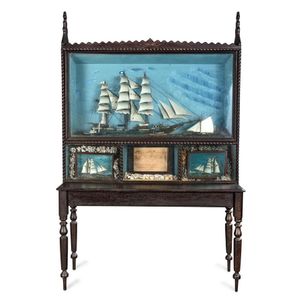Large-scale model of clipper ship 'Canterbury' in glazed vitrine
You must be a subscriber, and be logged in to view price and dealer details.
Subscribe Now to view actual auction price for this item
When you subscribe, you have the option of setting the currency in which to display prices to $Au, $US, $NZ or Stg.
- Kauri - An evergreen conifer tree associated with New Zealand, but also grown in northern Australia, and islands around the Pacific rim including Borneo, Vanuatu and New Guinea. The timber is generally golden in colour, and straight grained without much knotting.
A by-product of the kauri tree was the kauri gum, the fossilised resin extracted from the tree. The gum was obtained through digging, fossicking in treetops, or more drastically, by bleeding live trees. Kauri gum was used in the manufacture of varnishes and other resin-based products, and also crafted into jewellery, keepsakes, and small decorative items.
Kauri forests were prolific in the north of the North Island of New Zealand. European settlers in the 1700 and 1800s realised that the timber from these tall trees with broad trunks would be ideal for ship building and construction and a thriving industry was established harvesting the kauri tree. The forests were substantially reduced, and now the remaining Kauri trees that grow in New Zealand are protected, and there are reserves in various areas of the North Island.
The remaining stands of kauri in New Zealand are under threat from "kauri disease", a microscopic organism that causes dieback in the trees, with vast tracts either dead or dying.
This item has been included into following indexes:
Visually similar items

A large multiple panel glazed tall ship diorama on stand, dated 1889, together with a photograph of the maker Mr. Crawford, 2nd prize winner at the Mechanics Institute, Hamilton, August 1889, 210 cm high, 138 cm wide, 45 cm deep

A naive model ship 'The Gneisenau', in a glazed cedar case, based on the World War II German battle cruiser of the same name, within a glazed cedar case, 70 cm wide, 23 cm deep, 43 cm high

A Louis XVI style coromandel games table, France, late 19th century, the rectangular table top with a reeded bronze border, and finely inset with a decorative bone and string inlay inner border, above a bronze and bone mounted apron. The swiveling rectangu

A stunning model tallship in cabinet, huon pine, cedar and blackwood, Tasmanian origin, 19th century 162 cm high, 145 cm wide, 41 cm deep
